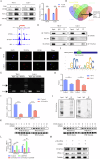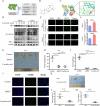Hexokinase HK3-mediated O-GlcNAcylation of EP300: a key regulator of PD-L1 expression and immune evasion in ccRCC
- PMID: 39179546
- PMCID: PMC11343739
- DOI: 10.1038/s41419-024-06921-1
Hexokinase HK3-mediated O-GlcNAcylation of EP300: a key regulator of PD-L1 expression and immune evasion in ccRCC
Abstract
Clear cell renal cell carcinoma (ccRCC) demonstrates enhanced glycolysis, critically contributing to tumor development. Programmed death-ligand 1 (PD-L1) aids tumor cells in evading T-cell-mediated immune surveillance. Yet, the specific mechanism by which glycolysis influences PD-L1 expression in ccRCC is not fully understood. Our research identified that the glycolysis-related gene (GRG) HK3 has a unique correlation with PD-L1 expression. HK3 has been identified as a key regulator of O-GlcNAcylation in ccRCC. O-GlcNAcylation exists on the serine 900 (Ser900) site of EP300 and can enhance its stability and oncogenic activity by preventing ubiquitination. Stably expressed EP300 works together with TFAP2A as a co-transcription factor to promote PD-L1 transcription and as an acetyltransferase to stabilize PD-L1 protein. Furthermore, ccRCC exhibits interactive dynamics with tumor-associated macrophages (TAMs). The uridine 5'-diphospho-N-acetylglucosamine (UDP-GlcNAc), which serves as a critical substrate for the O-GlcNAcylation process, facilitates TAMs polarization. In ccRCC cells, HK3 expression is influenced by IL-10 secreted by M2 TAMs. Our study elucidates that HK3-mediated O-GlcNAcylation of EP300 is involved in tumor immune evasion. This finding suggests potential strategies to enhance the efficacy of immune checkpoint blockade therapy.
© 2024. The Author(s).
Conflict of interest statement
The authors declare no competing interests.
Figures










References
MeSH terms
Substances
LinkOut - more resources
Full Text Sources
Medical
Molecular Biology Databases
Research Materials
Miscellaneous

